
A New Matrix Atlas
MacMillan, David M., ed., with material from Paul Hayden Duensing et. al. A New Matrix Atlas. (Mineral Point, WI: CircuitousRoot, 2014-2020)
This slim booklet entitled Matlas (for "Matrix Atlas"; see reprints below), written and compiled by the late Paul Hayden Duensing, was for its time the essential reference in the amateur and revivalist typefounding community for technical details about typecasting matrices.
But Duensing's Matlas was never issued in a final version or as an actual book. It was a series of typescripts which evolved over the years. That evolution was not necessarily cumulative; each version contains information not present in the other versions. A need still exists, therefore, for a compendium of all of the matrix information in Matlas, corrected when necessary and augmented when possible with data from other sources. This is an attempt to produce such a work.
Thanks are due to Ginger Duensing for her permission to use the material by Paul Hayden Duensing, and to many others in the typecasting community for their help.
Viewing Note: The PDF is set up like a conventional book, with odd numbered pages on the right if you view it two-up. If your screen is large enough for this, it works best if you set your viewer to "book mode" or "two-up, first page centered" mode and set it to "fit page" so that pages from 2/3 on display in proper pairs and new pairs start cleanly with the "page down" function.
Since this is an open source document, you need access to the source. Here is a tarball of its development directory: new-matrix-atlas.tar.gz
Perhaps more usefully, here are the DXF files for the engineering drawings of matrices. They'll work in LibreCAD, but may display incorrectly elsewhere.
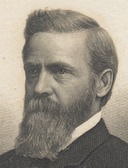
Beard Widths
A table of calculated beard withds over a selection of depths of drive and beard angles. This is also incorporated into the New Matrix Atlas, above.
Source spreadsheet: beard-widths.ods
Paul Hayden Duensing's Matlas ("matrix atlas") was the central compendium of technical information on typecasting matrices in the 20th century. There was never a single official published version of Matlas; it evolved over a number of years as a typescript distributed within the typecasting community. Each version contains information not present in the others. In the interest of preserving the memory of Duensing's work to the greatest extent possible, I have not compiled a single composite version, but instead have reprinted separately each version of which I am aware. If you are seriously interested in the typefounder's matrix, you should read all of them.
Note: According to the ATF Newsletter No. 17 (July 1993), p. 27, Duensing's Matlas was distributed at the 1988 ATF Conference.
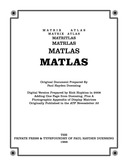
Matlas (Hopkins' 2008 Edition)
Duensing, Paul Hayden and Richard L. Hopkins, ed. Matlas: An Atlas of Matrices. Kalamazoo, MI: The Private Press and Typefoundry of Paul Hayden Duensing, 1988 and Terra Alta, WV: Hill and Dale Private Press and Typefoundry, 2008.
This 2008 edition is an electronic edition prepared by Richard L. Hopkins. It adds one additional page (page 6 of this 2008 edition) found in the late Paul Hayden Duensing's papers (with matrix drawings clearly intended for the original publication). It also has appended to it another page of photographs of matrices which appeared originally in the American Typecasting Fellowship's Newsletter , No. 32 (August, 2008).
When compared with the 1988 "16 page edition" (see below), this edition lacks one page of text (on US alignment and English small composition mats), tables 2, 3, 6, 7, 11, 12, 13, & 14, and the final page of unnumbered tables which are present in that edition.
When compared with the 1986 "14 page edition" (see below), it omits the copy of the actual English Monotype engineering drawing (with toleranced dimensions) of a square English display matrix.
This is a compact (6.1 Megabyte) PDF. Thanks are due to Rich Hopkins for preparing this digital edition and for allowing it to be presented here.
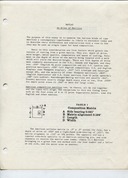
Matlas (1988 "16 Page" Version)
As far as I can determine this is a complete version of Matlas. It contains one page not present in the 2008 edition (page 2 of this edition). It also contains tables 2, 3, 6, 7, 11, 12, 13, and 14 missing from the 2008 edition, and a final page of unnumbered tabular information. However, it lacks the extra two pages of drawings and photographs added by Hopkins to the 2008 edition. (Note also that the extra page of drawings of Giant Caster and English Display mats drawn by Duensing and added to the 2008 edition differ from those drawn by Andrew Dunker and shown in Tables 6 and 7 of this edition.)
This edition came from a multigenerational photocopy that I purchased at the 2010 ATF Conference auction in a sheaf of miscellaneous papers, but I cannot now recall who I purchased it from. It's provenance is therefore unknown.
This digital reprint, prepared at 600dpi, is a rather large (137 Megabyte) PDF.
Several of the drawings in this edition are detailed, important to type-makers, and (unfortunately) hard to read. Here are links to high-resolution (1200dpi RGB PNG) versions of them, just in case you need to be quite sure you're reading a number correctly. (These are 10096 x 14039 pixel images at about 180 Megabytes each. You'll want to download them and view them offline.)
Matlas is an important document in typefounding and matrix making, so it is worth tabulating the differences, page by page, between these two editions:
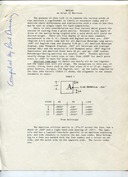
Matlas (1986 "14 Page" Version)
This is the earliest version of Matlas known so far. It is dated July 1986, and in it Duensing calls it a "talk" rather than an "essay." This version was found in the collection of Duensing's papers in the care of Richard L. Hopkins.
The primary item in it which is not present in later versions is multigenerational photocopy of the actual Monotype Corporation Ltd (UK) engineering drawing D3437, dated 6-2-29, for the 1" square 42pt - 60 pt English Display Matrix. This drawing has not only dimensions but tolerances on those dimensions. These tolerances were omitted in later drawings derived from this one.
The icon above left links to a 171 Megabyte PDF of this version.
The following errors appear in Matlas. Sadly, Paul Hayden Duensing is no longer with us to make a revised edition.
The correct depth of drive for Ludlow matrices is 0.153 inches, not 0.168. The corresponding blank slug height is 0.918 - 0.153 = 0.765 (not 0.750).
I have verified this in three ways. (a) By measuring an actual well-cast Ludlow slug. (b) By asking Schuyler Shipley, proprietor of Skyline Type Foundry, who knows the Thompson Type-Caster perhaps better than anyone else today (with appropriate equipment, the Thompson can cast from Ludlow matrices). (c) By reference to a Ludlow Typograph Company technical bulletin, "Uneven Ludlow Slug Height," by "EPF" (Edward P. Forman), which gives the Blank Slug Height as 0.765. This is as close to an official Ludlow company specification as I can find. This bulletin has been reprinted in James Parrish's Ludlow Field Service Notes (p. 111); this volume is still available from Dave and Beth Seat, Hot Metal Services: http://www.hotmetalservices.com/ .
2. It is not possible to cast Ludlow mats on the Thompson using a "Thompson space mold." Schuyler Shipley points out that while the numbers almost match, the geometry of the mold and the matrix holder will not produce the intended result and may damage the machine. Low spaces may be cast on the Thompson using a standard 0.050 Monotype mold adapted for casting spacing by the replacement of the Mold Front Wall Space Plate 42TC33 and the use of low space blades and low space matrices. This will result in spaces 0.763 high, which is very close to the 0.765 Ludlow blank slug height. However, the geometry of the Vertical Mold Blade and the face of the mold would still give a height of 0.918 if this were attempted (the Thompson low space matrix projects into the mold, giving the intended 0.763 height). Further, attempting to use a Thompson Ludlow matrix holder with a Monotype matrix mold will result in a holder position which is 0.105 further out than a Monotype matrix holder. It may not be possible to adjust the mat holder cam lever spring sufficiently to accomdate this, and damage to the cam lever may result. (We have not yet tested this to see if it is the case, as it wouldn't produce a useful result even if it worked.)
(3) In Duensing's discussion of the American Display Matrix (Table 4, on page 4 of this edition), he says that 'All American Monotype Display Mats have ... length of 80 points or 1.125", ...' He then goes on to give a handy table listing the head bearing and foot bearing for each of six body (point) sizes. The values are in points, and in each case the values given all sum to 80 points.
The problem is that 80 points is not 1.125". 80 * 0.0138,4 = 1.107,2 inches. Since a display mat is in fact 1 1/8 (1.125) inches, and since the sum of the values for each line in the table must equal the length of the matrix, something in the table must be wrong. I don't yet know what.
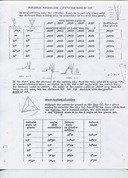
Duensing? Pantograph Charts
A four page typescript probably by Paul Hayden Duensing devoted primarily to pantographic punchcutting also contains, on its final page, a chart of dimensions for Lanston Monotype display, Thompson, and Iwata matrices. The icon at left links to a presentation of this document in the ../../../ Making Printing Matrices and Types -> Reprinted Literature -> Machine Engraving Notebook.
Various charts and tables presented elsewhere on CircuitousRoot may be of use to the machine typefounder.
Lanston Monotype never published an overall table of alignment information for their typefaces. This information was provided with each matrix font, either on a label or in the form of a physical alignment standard, or both. This information has often been lost, however, and for many non-Monotype faces (there was much more independent matrix making in the 20th century than is generally remembered) may never have been available, or even developed.
Here is some alignment information as assembled and used by various typefoundries. It is primarily for Lanston Monotype series, with some English Monotype and non-Monotype information as well.
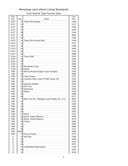
Skyline Type Foundry
Here is the alignment information as compiled/reconstructed and used by Skyline Type Foundry. It is presented here by permission of Schuyler Shipley, Prop. of Skyline. This information represents a tremendous amount of work on Sky's part; we owe him a great debt of gratitude for sharing it. Use it and share it freely, but please do not republish it for commercial gain without his permission.
Unless indicated otherwise, matrix font numbers are Lanston Monotype series numbers. The prefix 'E' on a series number indicates that it is an English Monotype series. The abbreviation "NM" indicates a non-Monotype matrix font. (While the utility of lining values for possibly unique non-Monotype matrix fonts may be questioned, they provide at least a starting value in the absence of anything else.)
Sky indicates that the alignment values are derived from the following sources, listed here in order of importance:
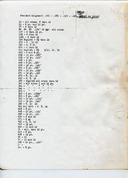
Barco / F&S Type Founders
Composition sizes (6 through 12 point). Mostly Lanston Monotype (with some English Monotype). As used by Barco / F&S Type Founders, Bensenville, IL. Reprinted with the kind permission of Sy Patel, proprietor of the former Barco / F&S Type Founders.
Regrettably, the information in this sheet is incomplete; in many cases it indicates that a particular series had non-standard alignment, but does not actually say what that alignment is.

'Monotype' [UK] Book of Information (1959)
'Monotype' Book of Information (London & Salfords, UK: The Monotype Corporation Limited, 1959). In addition to many other hand tables of information, this book gives the official lining standards for the then-current range of (English) Monotype typefaces in composition sizes (sometimes rather large composition sizes, but not in display sizes and therefore, one presumes, not for display matrices even when in these sizes).
Regrettably, under 2012 copyright law this book is in copyright in the UK through 2029 and in the US through 2054.
Finally, here's a table of values one needs to know when sorting through a pile of unidentified mold parts. The matrix drive data are from Matlas (corrected for Ludlow), with the addition of English Linotype (From Ashworth. Operation and Mechanism of the Linotype and Intertype. (London: Staples Press, 1955.))
Matrix Depths-of-Drive and Mold Heights (for US Type Height)):
Here's a spreadsheet version to print and post on the wall:
The 2008 edition of Matlas is copyright 2008 by Paul Hayden Duensing and Richard L. Hopkins. Rich Hopkins has kindly released it for noncommercial use by typefounding enthusiasts. Please do not reproduce it commercially without his permission.
The 1986 "14 page edition" of Matlas is copyright by Paul Hayden Duensing, and is reprinted here with the kind permision of Ginger Duensing. Please do not reproduce it commercially, and please attribute Paul Hayden Duensing as its author in any reference to it.
The 1988 "16 page edition" of Matlas is copyright by Paul Hayden Duensing, and is reprinted here with the kind permision of Ginger Duensing. Please do not reproduce it commercially, and please attribute Paul Hayden Duensing as its author in any reference to it.
All portions of this document not noted otherwise are Copyright © 2011, 2013-2015, 2020 by David M. MacMillan.
Circuitous Root is a Registered Trademark of David M. MacMillan.
This work is licensed under the Creative Commons "Attribution - ShareAlike" license, version 4.0 International. See http://creativecommons.org/licenses/by-sa/4.0/ for its terms.
Presented originally by Circuitous Root®